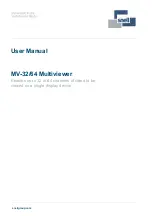
MV-32/64 Multiviewer
www.snellgroup.com
Introduction
Issue 1 Rev 11
Page 14
© 2014 Snell Limited
For each input is possible to display either the Ancillary Timecode or the DVITC from the
video source.
LTC is applied to the frame through a BNC on at the rear of the frame.
See section 4.5 for more information.
If VBI data is present on a video input and the video is an SDI source then the data can be
displayed on the relevant video tile (see sections 4.16.5.6 and 4.16.5.7 for setting details).
If multiple sources of timecode are present in a video source then the timecode selected for
display, in order of priority is; Ancillary VITC, Ancillary LTC and D-VITC.
2.2.5 Genlocking
Genlocking of the MV-32/MV-64 multiviewer is via SD color black or HD tri-level sync, using
the genlock input.
2.2.6 Using GPI I/O
Assignable GPI I/O with 16 inputs and 8 outputs for external alarm indication and tally
functions.
2.2.7 Bargraph scales
The following audio scales are supported:
Colors used for the upper and lower ranges of each bar type can be customized to satisfy any
in-house monitoring style for each of the six scale types.
For the MV-VIP3D cards the meters can be configured appropriately to display the levels of all
channels in a Dolby E stream (embedded audio only, not audio from external audio input
cards).
Note:
1.
D-VITC is only available on SD sources as there is currently no standard for HD
sources. Ancillary Timecode is available on both SD and HD sources.
2.
The Timecode is displayed in a fixed position near the bottom center of the tile
within the video.
3.
The display will start to be cropped when the tile is 150 pixels or less wide.
Fig 2.
Available Meter Scales.















































